
A colloid is a mixture in which one substance consisting of microscopically dispersed insoluble particles is suspended throughout another substance. Some definitions specify that the particles must be dispersed in a liquid, while others extend the definition to include substances like aerosols and gels. The term colloidal suspension refers unambiguously to the overall mixture. A colloid has a dispersed phase and a continuous phase. The dispersed phase particles have a diameter of approximately 1 nanometre to 1 micrometre.
Rheology is the study of the flow of matter, primarily in a fluid state but also as "soft solids" or solids under conditions in which they respond with plastic flow rather than deforming elastically in response to an applied force. Rheology is the branch of physics that deals with the deformation and flow of materials, both solids and liquids.
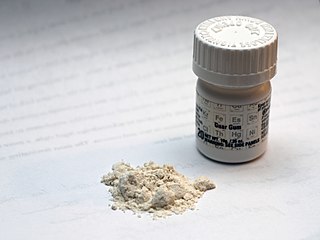
Guar gum, also called guaran, is a galactomannan polysaccharide extracted from guar beans that has thickening and stabilizing properties useful in food, feed, and industrial applications. The guar seeds are mechanically dehusked, hydrated, milled and screened according to application. It is typically produced as a free-flowing, off-white powder.
In physics and chemistry, a non-Newtonian fluid is a fluid that does not follow Newton's law of viscosity, that is, it has variable viscosity dependent on stress. In particular, the viscosity of non-Newtonian fluids can change when subjected to force. Ketchup, for example, becomes runnier when shaken and is thus a non-Newtonian fluid. Many salt solutions and molten polymers are non-Newtonian fluids, as are many commonly found substances such as custard, toothpaste, starch suspensions, corn starch, paint, blood, melted butter and shampoo.
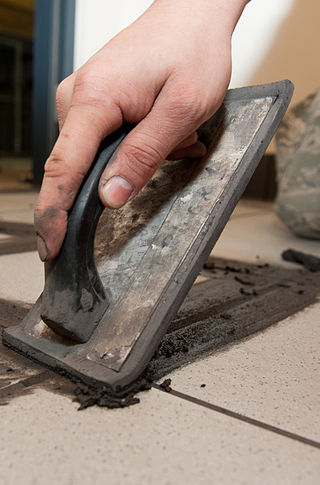
Grout is a dense fluid that hardens upon application and is used to fill gaps or as reinforcement in existing structures. Grout is generally a mixture of water, cement, and sand, and is employed in pressure grouting, embedding rebar in masonry walls, connecting sections of precast concrete, filling voids, and sealing joints such as those between tiles. Common uses for grout in the household include filling in tiles of shower floors and kitchen tiles. It is often color tinted when it has to be kept visible and sometimes includes fine gravel when being used to fill large spaces. Unlike other structural pastes such as plaster or joint compound, correctly mixed and applied grout forms a water-resistant seal.
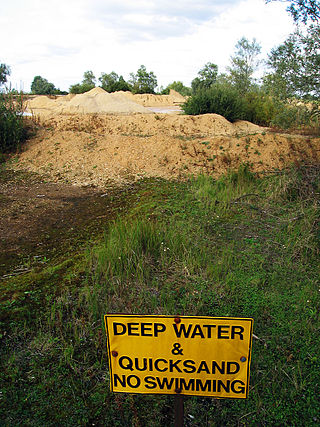
Quicksand is a colloid consisting of fine granular material and water. It forms in saturated loose sand when the sand is suddenly agitated. When water in the sand cannot escape, it creates a liquefied soil that loses strength and cannot support weight. Quicksand can form in standing water or in upward flowing water. In the case of upward-flowing water, forces oppose the force of gravity and suspend the soil particle.
In continuum mechanics, a power-law fluid, or the Ostwald–de Waele relationship, is a type of generalized Newtonian fluid for which the shear stress, τ, is given by
In materials science and continuum mechanics, viscoelasticity is the property of materials that exhibit both viscous and elastic characteristics when undergoing deformation. Viscous materials, like water, resist both shear flow and strain linearly with time when a stress is applied. Elastic materials strain when stretched and immediately return to their original state once the stress is removed.
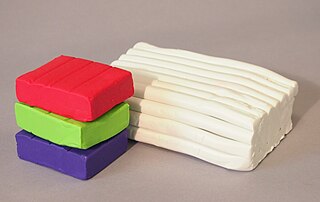
Polymer clay is a type of hardenable modeling clay based on the polymer polyvinyl chloride (PVC). It typically contains no clay minerals, but like mineral clay a liquid is added to dry particles until it achieves gel-like working properties. Similarly, the part is put into an oven to harden, hence its colloquial designation as clay. Polymer clay is generally used for making arts and craft items, and is also used in commercial applications to make decorative parts. Art made from polymer clay can now be found in major museums.

A dilatant material is one in which viscosity increases with the rate of shear strain. Such a shear thickening fluid, also known by the initialism STF, is an example of a non-Newtonian fluid. This behaviour is usually not observed in pure materials, but can occur in suspensions.
In continuum mechanics, rheopecty or rheopexy is the rare property of some non-Newtonian fluids to show a time-dependent increase in viscosity ; the longer the fluid undergoes shearing force, the higher its viscosity. Rheopectic fluids, such as some lubricants, thicken or solidify when shaken. The opposite and much more common type of behaviour, in which fluids become less viscous the longer they undergo shear, is called thixotropy.

A rheometer is a laboratory device used to measure the way in which a viscous fluid flows in response to applied forces. It is used for those fluids which cannot be defined by a single value of viscosity and therefore require more parameters to be set and measured than is the case for a viscometer. It measures the rheology of the fluid.
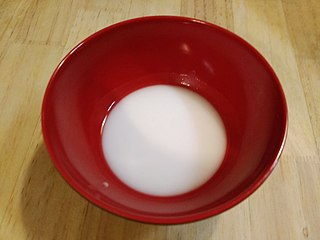
A thickening agent or thickener is a substance which can increase the viscosity of a liquid without substantially changing its other properties. Edible thickeners are commonly used to thicken sauces, soups, and puddings without altering their taste; thickeners are also used in paints, inks, explosives, and cosmetics.
Fluid mechanics is the branch of physics concerned with the mechanics of fluids and the forces on them. It has applications in a wide range of disciplines, including mechanical, aerospace, civil, chemical, and biomedical engineering, as well as geophysics, oceanography, meteorology, astrophysics, and biology.

In geotechnical engineering, drilling fluid, also known as drilling mud, is used to aid the drilling of boreholes into the earth. Used while drilling oil and natural gas wells and on exploration drilling rigs, drilling fluids are also used for much simpler boreholes, such as water wells.

In rheology, shear thinning is the non-Newtonian behavior of fluids whose viscosity decreases under shear strain. It is sometimes considered synonymous for pseudo-plastic behaviour, and is usually defined as excluding time-dependent effects, such as thixotropy.
Self-consolidating concrete or self-compacting concrete (SCC) is a concrete mix which has a low yield stress, high deformability, good segregation resistance, and moderate viscosity.

The viscosity of a fluid is a measure of its resistance to deformation at a given rate. For liquids, it corresponds to the informal concept of "thickness": for example, syrup has a higher viscosity than water. Viscosity is defined scientifically as a force multiplied by a time divided by an area. Thus its SI units are newton-seconds per square meter, or pascal-seconds.

In continuum mechanics, time-dependent viscosity is a property of fluids whose viscosity changes as a function of time. The most common type of this is thixotropy, in which the viscosity of fluids under continuous shear decreases with time; the opposite is rheopecty, in which viscosity increases with time.
Mechanics of gelation describes processes relevant to sol-gel process.













